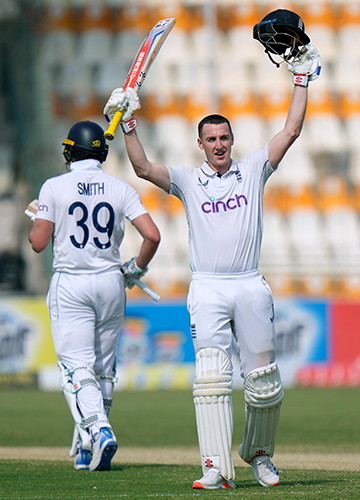Test cricket, considered the most conservative and sedate of the three formats, seems to be undergoing a dramatic makeover, if two matches played recently are any indication.
In the second India-Bangladesh Test in Kanpur, the hosts forced a seven-wicket win in just over two days in a rain-curtailed match. On the face of it, this may seem unremarkable: history shows some matches have been briefer. Also, Bangladesh isn’t exactly the strongest side playing currently.
However, what set this game apart was the manner in which India changed the tempo to chase victory when the pitch and situation suggested a draw was the likely outcome.
The match was turned on its head by India’s high-octane batting. Scoring at more than eight runs an over, India overhauled Bangladesh’s score in double quick time, declaring with a 52-run lead to take the attack to Bangladesh again, this time with ball.
Under pressure, Bangladesh wilted, leaving cricket watchers the world over in awe at India’s ruthless, relentless quest for victory.
Less than a fortnight later, England pulled off an equally dramatic win over Pakistan on a flat, run-loaded pitch at Multan.
Batting first, Pakistan posted a whopping 556, a score that foretold a dull and dreary draw unless the pitch started misbehaving badly. Instead, the England batters, throwing caution to the wind, not only chased Pakistan’s score with gusto, but overhauled it in commanding fashion.
Joe Root, riding a magnificent purple patch, hit a double century. And the precocious Harry Brook hammered 317, the second fastest triple century in Test history behind Virender Sehwag (against South Africa in Chennai, 2008).
England scored 823 at more than five runs an over! Pakistan were so shell-shocked that they crumbled for 220 on a pitch that still played true, leaving England winners by an innings and 47 runs.
What do these two matches tell us about the future of Tests? Were these happenstance outcomes or do they suggest a trend? Is an attacking, high-risk approach going to be the staple of Test cricket going ahead, and will it help reinvigorate the format?
I am inclined to go with the latter. As a Test cricket die-hard, I see the new ethos promising enough to make the longest format more result-driven, exciting and durable.
While the spotlight has been on aggressive batting, this is not the only reason I am optimistic. Batting exploits and achievements generally get more attention in the sport. But as the old saying goes, it is bowling that wins matches.
At Kanpur and in Multan, the results would not have been in favour of India and England had the bowlers and fielders not delivered.
While excellence in all three departments is a prerequisite for success in the sport, what is truly transforming Tests is the change in the mindset of the players, particularly of those in charge of teams. The pursuit of victory has become fundamental. Captains are willing to take high risks, at times even tempting defeat. This cultural shift has become more pronounced in recent years, England leading the way with BazBall under Ben Stokes and Brendon McCullum, and India willing to take it a step further under Rohit Sharma.
Test results have been on the upswing since the turn of the century, but have seen a sharp rise in the past decade going by the last two cycles of the World Test Championship, which has given five-day cricket a more significant locus standi than before. In the 2019-2021 cycle, 120 matches were played, of which eight ended in draws. In the ongoing 2023-25 cycle, only three of 88 matches played so far have resulted in draws.
How much is the growth of T20 influencing this change?
Quite substantially, and contrary to all initial apprehensions, in a positive way. Batters have become more adventurous. Lofted shots, once anathema in red-ball cricket, are commonplace now. It was feared T20 would ruin bowling, but that threat hasn’t held true. Bowlers have adjusted, become experimental, and made their skills more nuanced to succeed in T20s and in other formats. Fielding has perhaps gained the most from T20: cricketers, traditionally picked for their specific skills, have to first be athletes now to play in any format.
Technical aspects aside, huge financial rewards from T20 have made the future of players more secure and hence they are not averse to taking risk. Simultaneously, intense competition, including from teammates, is compelling players to constantly sharpen their skills.
There are fall-outs, too, no doubt. Not all players can adjust to all formats easily and the casualty rate is high. Careers can be short-lived. That said, the best players adapt and have long, fruitful careers.
The bigger concern is the proliferation of cash-rich T20 leagues luring away high-quality Test cricketers, as has been evident from the struggles of the West Indies, South Africa, Bangladesh and Sri Lanka. This is widening the chasm between the top four-five teams and the rest, which needs to be addressed.
Test cricket is the original, some say purest, form of the game. Most players, even in this three-format era, swear by it as their most preferred. Yet, retaining the relevance of Test cricket remains the biggest challenge for administrators and players alike.
An environment that encourages players to give their best without compromising on being fiercely competitive on the field is the panacea that Test cricket needs. Bold, imaginative leadership, fair selection and stable administration to diminish fear of failure among players are ingredients that will give this ethos good health. Though Test cricket is rocking like never before, I must end with a caveat: drawn Tests can also be intensely dramatic and rewarding for players and fans alike, and must not be obfuscated in reckless pursuit of glory.



